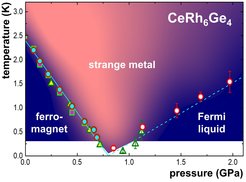Strange metal behavior in a pure ferromagnetic Kondo lattice
Physicists discover a new kind of strange metal
In the quest to harness quantum mechanics for new kinds of materials and new kinds of technologies, physicists are turning to the study of ‘quantum materials’ where the effects of quantum mechanics give rise to new forms of collective behavior. Normal metals, such as copper, gold or aluminum are well understood in terms of the quantum mechanics of individual electrons, and their resistivity depends linearly on temperature due to scattering of electrons by the vibrations of the lattice of atoms. At low-temperatures however, the lattice quiets down and the electrons propagate without much scattering. However, a class of metals called ‘strange metals’ show resistivity behavior that is linear in temperature all the way down to the lowest experimentally accessible temperatures. This is often observed when the metals, under applied pressure or magnetic field, undergo a phase transition into a magnetically ordered phase. At the brink of magnetism, the strange metals exhibit a marked propensity towards unconventional superconductivity. Such strange metals are of great current interest, because they may reveal important new insights into the physics of collective electron behavior and the origin of high temperature superconductivity.
It has long been assumed that strange metals are associated with ‘anti-ferromagnetism’, a type of magnetism in which electrons at adjacent atoms tend to have their magnetic moments pointing in antiparallel directions. Electrons in such antiparallel configurations have a propensity to become quantum mechanically ‘entangled’, so that they exist in a spooky quantum state that is simultaneously up-down and also down-up, the electronic analog of the Schrödinger cat. It has been conjectured that strange metallic behavior would never develop near a ferromagnetic instability, where the electron spins are aligned in a single direction (as in ordinary magnets) and are unable to become quantum mechanically entangled. A few years ago, a group at MPI CPfS observed evidence of a ferromagnetic instability in the substituted heavy fermion metal YbNi4(P1-xAsx)2 [Science 339, 933 (2013)]. However, this report was received with some skepticism as here, the ferromagnetic instability can be simulated by the alloying-induced disorder.
Together with M. Smidman, H. Q. Yuan and collaborators at the Center for Correlated Matter at Zhejiang University, Hangzhou, Y. Komijani and P. Coleman from Rutgers University, R. Borth, M. Nicklas and F. Steglich from MPI CPfS were able to detect that the pristine heavy fermion ferromagnet CeRh6Ge4 exhibits a ferromagnetic instability under the ‘clean’ tuning parameter hydrostatic pressure [Nature 579, 51-55 (2020)]. On pressurizing single crystals of CeRh6Ge4 to suppress the ferromagnetic order to absolute zero, this material develops the strange metallic behavior only previously seen in antiferromagnetic systems, and long thought to be impossible in a ferromagnet. An important clue to this behavior is that CeRh6Ge4, like YbNi4(P1-xAsx)2, is extremely magnetically anisotropic, a property which not only restricts the direction of the ferromagnetism to a plane but in doing so, also injects entangled electron spin pairs into the ferromagnet. This result confirms the role of electron entanglement as a key element of the strange metal and opens an important new route for understanding and developing quantum materials and technologies.
FS / MN
![Experimental set up for specific-heat measurements under high pressure and at low temperatures down to 50 mK at the MPI-CPfS. The photograph shows the pressure cell made out of copper beryllium fixed in the experimental rig. The pressurized CeRh6Ge4 sample sits inside the pressure cell. Further details can be found in M. Nicklas, Pressure Probes, in Strongly Correlated Systems, eds. A. Avella and F. Mancini, Springer Series in Solid-State Sciences 180, Springer (2015) [DOI: 10.1007/978-3-662-44133-6_6].](/3182979/original-1583405305.jpg?t=eyJ3aWR0aCI6MjQ2LCJvYmpfaWQiOjMxODI5Nzl9--ad8bbd4217169507eef379c734d03e38766c759b)
Experimental set up for specific-heat measurements under high pressure and at low temperatures down to 50 mK at the MPI-CPfS. The photograph shows the pressure cell made out of copper beryllium fixed in the experimental rig. The pressurized CeRh6Ge4 sample sits inside the pressure cell. Further details can be found in M. Nicklas, Pressure Probes, in Strongly Correlated Systems, eds. A. Avella and F. Mancini, Springer Series in Solid-State Sciences 180, Springer (2015) [DOI: 10.1007/978-3-662-44133-6_6].

Phase diagram of pressurized single crystals of CeRh6Ge4. The ferromagnetic order is suppressed to absolute zero at a modest hydrostatic pressure.
![Experimental set up for specific-heat measurements under high pressure and at low temperatures down to 50 mK at the MPI-CPfS. The photograph shows the pressure cell made out of copper beryllium fixed in the experimental rig. The pressurized CeRh6Ge4 sample sits inside the pressure cell. Further details can be found in M. Nicklas, Pressure Probes, in Strongly Correlated Systems, eds. A. Avella and F. Mancini, Springer Series in Solid-State Sciences 180, Springer (2015) [DOI: 10.1007/978-3-662-44133-6_6]. Experimental set up for specific-heat measurements under high pressure and at low temperatures down to 50 mK at the MPI-CPfS. The photograph shows the pressure cell made out of copper beryllium fixed in the experimental rig. The pressurized CeRh6Ge4 sample sits inside the pressure cell. Further details can be found in M. Nicklas, Pressure Probes, in Strongly Correlated Systems, eds. A. Avella and F. Mancini, Springer Series in Solid-State Sciences 180, Springer (2015) [DOI: 10.1007/978-3-662-44133-6_6].](/3182979/original-1583405305.jpg?t=eyJ3aWR0aCI6MzQxLCJmaWxlX2V4dGVuc2lvbiI6ImpwZyIsIm9ial9pZCI6MzE4Mjk3OX0%3D--e0b3b25f371ecc183716367f7b7674398bdd808c)
